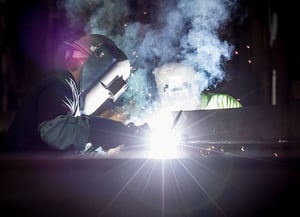Best Practices for Welding With Nickel Alloys

When using CWI nickel-based alloys, no post weld treatment is needed to maintain corrosion-resistance. If your main goal is to resist pitting, crevice or stress-corrosion cracking, read on for best practices when welding with nickel alloys.
High-nickel alloys are designed to withstand highly corrosive environments most generally associated with high-pressure environments and elevated temperatures. You’ll frequently find them used in oil and gas, aerospace, and power-generating industries for joining and cladding. Nickel alloys with higher percentages of copper, (CuNi-Gen 413 or NiCu-Gen 418, for instance) are often used to fabricate hardware in marine, chemical, and desalination construction.
Nickel alloys have a low thermal conductivity, resist scaling and oxidation at elevated temperatures, and do not harden without special effort and technique. Even when faced with multiple heating and cooling cycles they retain these properties.
Things to be aware of when welding with nickel and nickel alloys:
- When using nickel-based consumables, the weld joint must be opened wider to allow for better accessibility.
- During welding, nickel forms a tenacious viscous oxide, which limits the wettability and flow of the weld metal. Adding helium (25% to 50%) to the shielding gas can help wet the puddle.
- Welding nickel is highly susceptible to embrittlement when it comes into contact with sulfur, phosphorus, and lead at elevated temperatures. These contaminants can exist in grease, oil, paint, marking crayons or inks, forming lubricants, cutting fluids, shop dirt, and processing chemicals. The joint to be welded must be well-cleaned before work begins.
They can be used with most welding processes, and CWI (Central Wire Industries) Welding Generation4 manufactures an assortment of nickel-based and high nickel welding consumables for TIG, MIG, SAW, and SMAW processes.
